Thaipusam
Thaipusam or Thaipoosam (Tamil: தைப்பூசம், Taippūcam ?), is a festival celebrated by the Tamil community on the full moon in the Tamil month of Thai (January/February), usually coinciding with Pushya star, known as Poosam in Tamil. The festival is also observed among Keralites and is vernacularly called Thaipooyam (Malayalam: തൈപ്പൂയം).[1] It is mainly observed in countries where there is a significant presence of Tamil community such as India, Sri Lanka, Malaysia,[2] Mauritius,[3] Singapore,[4] South Africa, Canada and other places where ethnic Tamils reside as a part of the local Indian diaspora population such as Réunion, Indonesia, Thailand, Myanmar, Trinidad and Tobago, Guyana, Suriname, Jamaica and the other parts of the Caribbean.
| Thaipusam
தைப்பூசம் | |
|---|---|
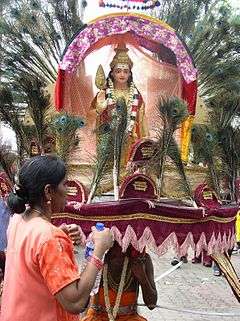 Murugan during Thaipusam in Malaysia. | |
| Also called | தமிழர் திருவிழா |
| Observed by | Tamils, Keralites, Sri Lankan Tamils, Malaysian Tamils, Tamil Singaporeans, Tamil Indonesians, Tamil Caribbeans, Tamil Fijians, and Tamil Mauritians |
| Type | Ethnoreligious |
| Significance | The festival commemorates the occasion when Parvati gave Murugan (aka Kartikeya) a Vel |
| Date | decided by the Tamil calendar. |
| 2020 date | Saturday 8 February |
| 2021 date | Thursday 28 January |
It is a national holiday in many countries like Malaysia, Sri Lanka, Mauritius. In certain states of Malaysia and in the nations of Sri Lanka and Mauritius it is a government and a bank holiday. In Singapore , it was previously a national holiday but was removed from the official list of national holidays to improve business competitiveness.[5]
The word Thaipusam is a combination of the name of the month, Thai, and the name of a star, Pusam. This particular star is at its highest point during the festival. The festival commemorates the occasion when Parvati gave Murugan (aka Kartikeya) a Vel "spear" so he could vanquish the evil demon Soorapadman. It is commonly believed that Thaipusam marks Murugan's birthday; Some other sources suggest that Vaikhasi Vishakam, which falls in the Vaikhasi month (May/June), is Murugan's birthday.[6]
Origin
| Part of the series on |
| Kaumaram |
|---|
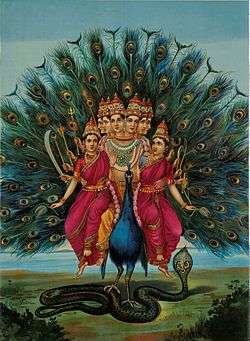 |
|
Six sacred abodes
|
|
This festival was (according to one tradition) said to have been supposedly created during one of the battles between the Asuras (or to be more specific Soorapadman) and the Devas. At one point, the latter were defeated several times by the former. The Devas were unable to resist the onslaught of the Asura forces. In despair, they approached Shiva and entreated to give them an able leader under whose heroic leadership they might obtain victory over the Asuras. They surrendered themselves completely and prayed to Shiva. Shiva granted their request by creating the mighty warrior, Skanda, out of his own power or Achintya Shakti. He at once assumed leadership of the celestial forces, inspired them and defeated the Asura forces and to recognise that day the people created the festival, Thaipusam.
According to Skanda Puranam, the legend of Murugan, and Thirupugal which are divine verses on Murugan, adhere to Shaivam principles. Murugan is the embodiment of Shiva's light and wisdom and devotees pray to him to overcome the obstacles they face, as He is the divine vanquisher of evil. The motive of Thaipusam festival is to pray to God to receive his grace so that bad traits are destroyed.[7]
Kavadi Attam
The Kavadi Attam ("kavadi dance") is a ceremonial act of devotional sacrifice through dance, food offerings, and bodily self-mortification. It is often performed by devotees during the festival of Thaipusam in honor of Murugan. The kavadi is a semicircular, decorated canopy supported by a wooden rod that the pilgrim carries on their shoulders to the temple. The devotee makes the pilgrimage (the nadai payanam) with bare feet, bearing food offerings on the kavadi. Depending on the location of the temple, this walk to the temple can take more than a week. The temple of Murugan in Palani is a popular destination, as it is one among the arupadai veedu ("six houses" - the sites sacred to Murugan). The Palani Murugan temple also has a reputation as a place of healing. Bogar (an ancient siddhar and devotee of Murugan) made the statue of Murugan in Palani, with the mixture of several sidhha medicines.
Devotees prepare for the celebration by keeping their body always clean, doing regular prayers, following a vegetarian diet and fasting before the Thaipusam. Kavadi-bearers have to perform elaborate ceremonies at the time of assuming the kavadi and at the time of offering it to Murugan. The kavadi-bearer observes celibacy and consumes only certain types of foods known as satvik food, once a day, while continuously thinking of God. On the day of the festival, devotees shave their heads and undertake a pilgrimage along a set route, while engaging in various acts of devotion, notably carrying the various types of kavadi. The devotees believe that worshiping lord Murugan every year in this way makes them physically and mentally healthy, and helps clear them of karmic debts they may have incurred.
At its simplest, the pilgrimage may entail walking the route carrying a pot of milk, but mortification of the flesh by piercing the skin, tongue or cheeks with vel skewers is also common. In addition, some pierce their tongues or cheeks, all the way through, with a small spear.[8]
A similar practice is performed by the Nagarathar community in Pazhani, India. This is known as the Nagarathar Kavadi.
Thaipusam in India
In Palani Sri Dhandayuthapani temple, 10 day Festival (Brahmotsavam) is held during Thaipusam. Thirukalyanam (Celestial Wedding) will be held on the day before Thaipusam. On Thaipusam, Therottam will be held. Lord Muthukumaraswamy will bless devotees in Thanga Guthirai Vahanam (Golden Horse), Periya Thanga Mayil Vahanam (Golden Peacock), Theppotsavam (Float Festival) during the 10 day festival.
In Chidamabaram (Thillai) Panchamurthi Veedhi Ula, Thirthavari, Thaandava Darsanam Aarthi will be held on Thaipusam. In Madurai Sri Meenakshi Amman Temple, Sri Meenakshi Sundareshwarar Theppotsavam (Float Festival) will be held at Mariammam Theppa Kulam. In Mylapore Kapaleeswarar Temple, 3 Day Theppotsavam will be held during Thaipusam Pournami.[9]
Outside India
Outside India, Thaipusam celebrations take place in USA, Mauritius, Malaysia, South Africa and Singapore.[10]
It is a public holiday in several states in Malaysia. In Malaysia, the temple at Batu Caves, near Kuala Lumpur & Arulmigu Balathandayuthapani Temple, Penang near George Town, Penang & Nattukkottai Chettiar Temple, Penang and Ipoh Kallumalai Murugan Temple,Perak, often attracts over one million devotees and tens of thousands of tourists.[11]
In Singapore, Hindu devotees start their procession at the Sri Srinivasa Perumal Temple in the early morning, carrying milk pots as offerings or attaching "kavadis" and spikes pierced on their body.[12] The procession travels for 4 kilometres before finishing at Tank Road, Sri Thendayuthapani Temple.[13][14][15]
Thaipusam in Mauritius is celebrated with thousands of attendees taking Cavadee. While the festival is celebrated across the country, the grandest one is always at Kovil Montagne (Sri Siva Subramanya Thirukovil). Nestled in Corps de Garde Mountain in Quatre Bornes, it was founded in 1890 by a humble and pious Tamil Indian immigrant, Velamurugan.
Also celebrated at nearby islands of Seychelles and Reunion
Thaipusam Kavady ceremony is celebrated in cities of Durban (Clairwood Shree Siva Soobramonior Temple) and Cape Town of South Africa.
At Fiji , the Thaipusam Festival is celebrated at Sri Siva Subrahmanya Swami Temple , Nadi Town.
In Indonesia, the procession mainly held in the capital of North Sumatra province, Medan. On the eve of Thaipusam, the Hindus gathered together at Sree Soepramaniem Nagarattar Temple at Kejaksaan Road to accompanying a 125 years old chariot or locally known as Radhoo from the temple to the main temple
nearby (about 2–3 kilometres or 1–2 miles) at Sri Mariamman Temple at Kampung Madras which opens 24-hours for the festival. The kavadi procession are also happening at the day, but it takes on different temples around Medan and other parts in the province depends on them celebrate it.
In the United States of America, the Shiva Murugan Temple in Concord, California celebrates the Thaipoosam preceded by a walk. Some people walk more than 74 km (46 mi) from the city of Fremont, some walk 34 km (21 mi) from the city of San Ramon to Concord, and most walk 11 km (7 mi) from Walden Park in Walnut Creek to Concord. Over 2000 people participated in the walk for last several years.
Gallery
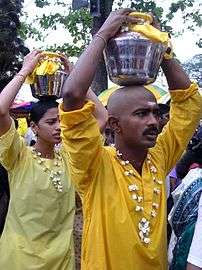 Devotees carry 'paal kudam' offerings at Thaipusam festival
Devotees carry 'paal kudam' offerings at Thaipusam festival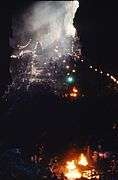 Batu Caves, Malaysia during Thai Pusam 1985
Batu Caves, Malaysia during Thai Pusam 1985.jpg) Thaipusam in Mauritius
Thaipusam in Mauritius.jpg) Thaipusam procession in Singapore
Thaipusam procession in Singapore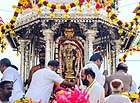 Silver chariot procession on Thaipusam eve in Penang, Malaysia
Silver chariot procession on Thaipusam eve in Penang, Malaysia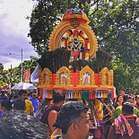 Penang thaipusam kavadi procession
Penang thaipusam kavadi procession
See also
- Hinduism in Southeast Asia
- Hinduism in Malaysia and Singapore
- Indians in Malaysia and Singapore
- Thai Poosam Kavady
References
- https://www.keralatourism.org/event/thaipooyam-festival-haippad/46
- "Malaysia : AllMalaysia.info has all you want to know about Malaysia". Allmalaysia.info. Retrieved 6 January 2011.
- "Festivals, Cultural Events and Public Holidays in Mauritius". Mauritius Tourism Authority. Archived from the original on 20 January 2012. Retrieved 28 January 2012.
- Thaipusam in Singapore.
- "MOM: Bid to make festival a public holiday will stir competing claims". City: World. The Strait times. TNN. 14 February 2015. Retrieved 21 January 2020.
- "Vaikasi Visakam and Lord Murukan LALALALA". Murugan.org. Retrieved 6 January 2011.
- Significance of Thaipusam Archived 13 February 2013 at the Wayback Machine, OmTamil published 15 October 2012
- Palani Thai Pusam, accessed 5 December 2006
- K, Kandaswamy. "Thaipusam in Palani, Tamil Nadu (India)". Live Trend. K Kandaswamy. Retrieved 23 November 2017.
- Thaipusam celebrations in South East Asia.
- 1.3 million mark Thaipusam – Star newspaper. Archived 3 April 2007 at the Wayback Machine
- Loh, Larry (2 February 2010). "Thaipusam 2010: Faith, ritual and body piercings". CNNGo.com. Archived from the original on 14 June 2010. Retrieved 6 January 2011.
- "Thaipusam | Sri Srinivasa Perumal Temple, Singapore, Singapore". Whatsonwhen. 24 November 2010. Archived from the original on 22 July 2011. Retrieved 6 January 2011.
- Cheney S (8 February 2009). "8,000 Hindu devotees take part in Thaipusam festival". Channel News Asia.
- (1996) Pancorbo, Luis: "Los picados de Thaipusam" en "Fiestas del Mundo. Las máscaras de la Luna". pp. 85–93. Ediciones del Serbal. Barcelona. ISBN 84-7628-168-4
External links
| Wikimedia Commons has media related to Thaipusam. |
- Thaipusam date calculator As the date of Thaipusam is determined based on the position of the Sun and the Moon the date varies slightly depending on where you are. When using this link check the city that the web site is calculating for and adjust it if needed.

